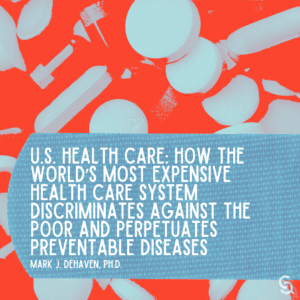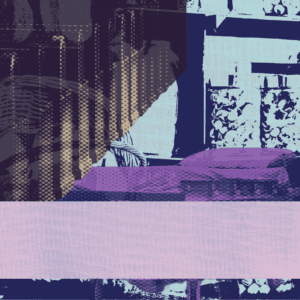 (Editor’s note: This is Part 2 of a 4-part health care series. You can access Part 1 on health as a social outcome and social factors here; Part 3 on the growing mental health crisis here; and Part 4 on health, communities, and the role of the church here.)
(Editor’s note: This is Part 2 of a 4-part health care series. You can access Part 1 on health as a social outcome and social factors here; Part 3 on the growing mental health crisis here; and Part 4 on health, communities, and the role of the church here.)
Americans are increasingly frustrated and angry about the state of health care in the U.S. The horrific assassination of a health care system CEO recently shocked the industry, but was met with complacency—and even acceptance—among some segments of the public. Insurance companies and hospitals routinely deny approved medical procedures and erect barriers to processing legitimate claims. Medical bills account for 40% of all personal bankruptcies.
Most Americans support the Affordable Care Act (ACA) and feel the federal government should guarantee health care for all. Yet, the ACA faces an uncertain future, and Medicaid coverage for the underserved is being reduced rather than expanded.
According to every indicator, the U.S. health care system is a failing system. It is the least efficient, most expensive, and least equitable among all wealthy nations. It ranks first in only one category: cost—it accounts for 7.6% of total costs in the U.S. compared to 3.8% in comparable countries.
It accounts for 17.6% of GDP and costs $5.0 trillion annually. The per capita cost is $14,570—compared to $6,600 in other wealthy countries. Although more costly, the U.S. system ranks last in overall performance, access to quality care, administrative efficiency, health equity, and health care outcomes.¹ Americans die earlier and are less healthy than people in other wealthy countries.
A “non-system” of “sick care”
The U.S. health care system does not align with World Health Organization (WHO) standards for a well-functioning health care system and is considered a “non-system” of care.
Non-systems lack a unified structure for managing care delivery, so care is fragmented and uncoordinated, and places emphasis on an individual’s ability to pay. Non-systems have broad variations in quality, high costs, poor outcomes, and favor treatment over prevention.²
The American Medical Association (AMA), American Public Health Association (APHA), National Council of Churches (NCC), most major religious denominations, and the [THE MAJORITY OF THE?] American public all support Universal Health Care (UHC). UHC ensures that all people have equal access to the full continuum and quality of health services—from health promotion to palliation—without personal financial hardship. Since the U.S. rejects UHC, it is often portrayed as a “sick care” system, focused more on treating rather than preventing disease. Sick care is more expensive, since it relies on costly treatments.
The APHA estimates that every dollar spent on prevention saves $5.60 in treatment costs. About 75% of U.S. expenses go to treating preventable conditions like heart disease, cancer, type II diabetes, and stroke. Yet, 95% of U.S. spending is for treatment and only 5% for prevention.³
Health consequences of a failing system
Preventable chronic illnesses have become a way of life for multiple generations of Americans. They now account for more than 70% of deaths. Although chronic illness is multicausal, overreliance on treatment-based health care is a primary factor. And although access to health care accounts for only about 20% of health outcomes, it is essential for living a long and productive life.
Before the ACA, 45 million Americans had no health insurance. Today the number is 25 million. The uninsured are more likely to not seek—or to postpone—needed care due to cost.
Thus, they are less likely to receive preventive care, more likely to be hospitalized for preventable conditions, and more likely to be diagnosed with late-stage cancer.⁴ Inequitable access to care contributes to increased levels of chronic disease, and lower overall levels of health, length of life, and untreated disease based on race, ethnicity, and income.⁵ ⁶
The uninsured tend to be the working poor—people who work low-wage jobs and live in poverty. They are disproportionately racial and ethnic minorities: American Indian and Alaska Native (AIAN; 18.7%), Hispanic and Latino (17.9%), Native Hawaiian and Pacific Islander (NHPI; 12.8%), and Black (9.7%), compared to their white counterparts (6.5%).⁷ As a consequence of health care access and outcome inequities, wealthy Americans now live as much as 15 years longer than poor Americans.⁸
Profits over people: Community benefit and the need for reform
Health care options for the poor are becoming more limited as health care has become a major industry, often more focused on the corporate bottom line than on patient health. The number of public “safety net” hospitals whose mission is to provide care for the underserved has declined by almost half since 1980.
The remaining for-profit and non-profit hospitals are part of corporations that see health care more as a business than a social responsibility. They seek to maximize profits and do not welcome the poor.
Nonprofit hospitals are required by the IRS to provide community health benefits, including charity care for low-income patients without insurance. However, there are no minimum standards, and hospitals decide who and what qualify for charity care.
According to the nonpartisan Lown Institute, 80% of hospitals receive far more in tax benefits than they provide in charity care. For example, the non-profit system in North Carolina with the largest tax exemption dedicates less than 60% of its tax benefit to caring for the poor. The system has accumulated $8.4 billion in unrestricted reserves, and many of its hospitals have profit margins exceeding 30%.⁹
The need for reform
The need to reform health care in the U.S. is long overdue. The current system is inequitable and contributes to epidemic levels of persistent chronic disease. Especially troubling are the human costs inflicted on the poor, who suffer a disproportionate share of the disease burden. When groups of people are systematically denied routine access to medical care and are subjected to increased risk of disease and diminished quality of life, it is unjust and contradicts every basic Christian value.
And when large health care corporations focus on profits and stockpile wealth at the expense of people in need, it is obscene—and challenges Christians to act on behalf of those whose lives and well-being are at peril.
After dedicating his life to eliminating disease among the world’s poorest and most vulnerable citizens, the Harvard physician/anthropologist Dr. Paul Farmer concluded, “the idea that some lives matter less is the root of all that is wrong with the world.”
He spoke eloquently of putting the needs of the poor and vulnerable first, as instructed by Catholic Social Teaching and Matthew 25:31–46. In the face of discrimination in health care and impending reductions in the ACA and Medicaid, Christians cannot remain silent. We are being called into action, as was Esther, “…for such a time as this.” (Esther 4:14)
The Hebrew phrase Tikkun Olam means “repair the world,” and in modern usage refers to social action and the pursuit of justice. Trinity Moravian Church in Winston-Salem, NC, embodies the spirit of Tikkun Olam with their Debt Jubilee Project begun in 2022.¹⁰ The congregation raises funds for the sole purpose of purchasing medical debt for pennies on the dollar from third-party debt collectors. So far, they have retired $21 million of medical debt from thousands of local families.
In such a time as this, Christians must think creatively about our role in reducing health inequity in ways that will “…loose the chains of injustice… to set the oppressed free” (Isaiah 58:6).
References
1. Schneider E, Sarnak D, Squires D, Shah A, Doty M. Mirror, mirror 2017: international comparison reflects flaws and opportunities for better U.S. health care. Commonw Fund. 2017;9:1-30.
2. Moseley GB. The U.S. Health care non-system, 1908-2008. Virtual Mentor. 2008 May 1;10(5):324-31. doi: 10.1001/virtualmentor.2008.10.5.mhst1-0805. PMID: 23211988.
3. U.S. Department of Health and Human Services. Steps to a healthier U.S. Washington (DC): Office of Public Health Promotion; 2001.Available from: URL: http://www.healthierus.gov/steps/steps_brochure.pdf
4. The Kaiser Commission on Medicaid and the Uninsured. Access to care for the uninsured: an update (2003). Available from http://www.kff.org/uninsured/4142.cfm.
5. Fiscella K, Franks P, Gold MR, Clancy CM. Inequalities in racial access to health care. JAMA. 2000;284(16):2053.
6. Braveman PA, Cubbin C, Egerter S, Williams DR, Pamuk E. Socioeconomic disparities in health in the United States: what the patterns tell us. Am J Public Health. 2010;100(suppl 1): S186-S196.
7. Hill L, Artiga S, Damico A. Health Coverage by Race and Ethnicity, 2010-2023. Kaisar Family Foundation. Published: Feb 13, 2025
8. Chetty R, Stepner M, Abraham S, et al. The Association Between Income and Life
Expectancy in the United States, 2001-2014. JAMA. 2016;315(16):1750–1766. doi:10.1001/jama.2016.4226
9. North Carolina Hospitals: Charity Care Case Report. North Carolina State Health Plan & Johns Hopkins Bloomberg School of Public Health. Oct. 27, 2021.
10. Craver, R. Church’s Debt Jubilee Project surges past latest fundraising goal. Hickory Daily Record. January 13, 2025.
 Dr. Mark J. DeHaven is a Distinguished Professor Emeritus of Public Health Sciences at UNC Charlotte. A leader in community medicine, his NIH- and CDC-funded research has improved health outcomes in underserved populations. Previously, he founded community medicine and community health science divisions at UT Southwestern Medical Center at Dallas. Recognized globally, he helped develop sustainable health models in the U.S., Mexico, Peru, and China, bridging research and real-world impact.
Dr. Mark J. DeHaven is a Distinguished Professor Emeritus of Public Health Sciences at UNC Charlotte. A leader in community medicine, his NIH- and CDC-funded research has improved health outcomes in underserved populations. Previously, he founded community medicine and community health science divisions at UT Southwestern Medical Center at Dallas. Recognized globally, he helped develop sustainable health models in the U.S., Mexico, Peru, and China, bridging research and real-world impact.


